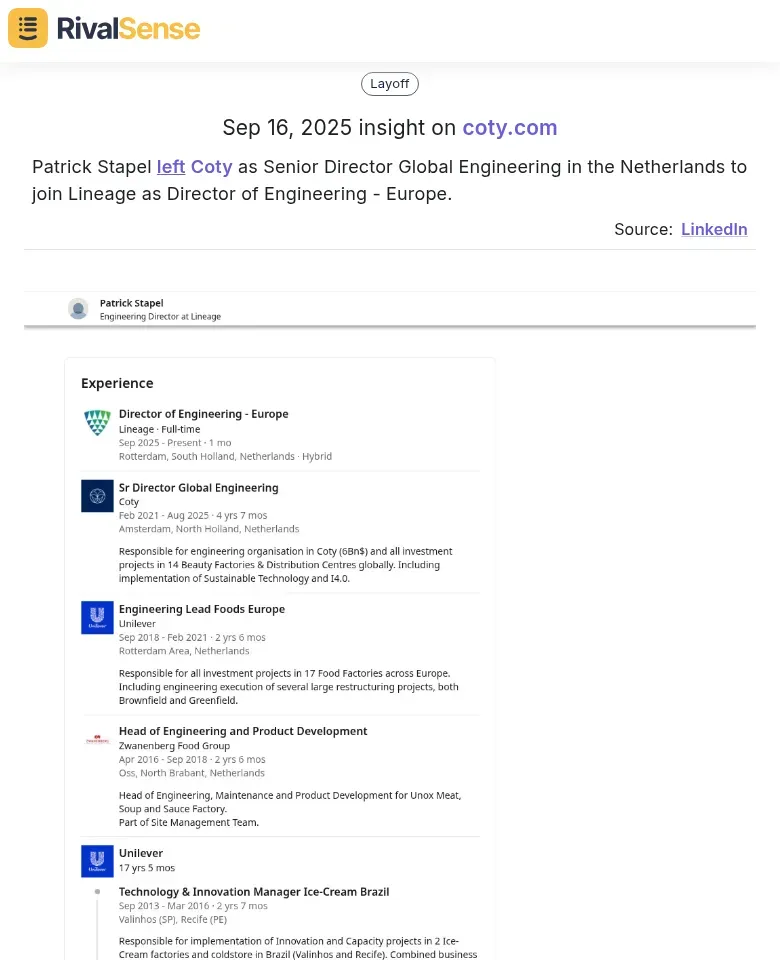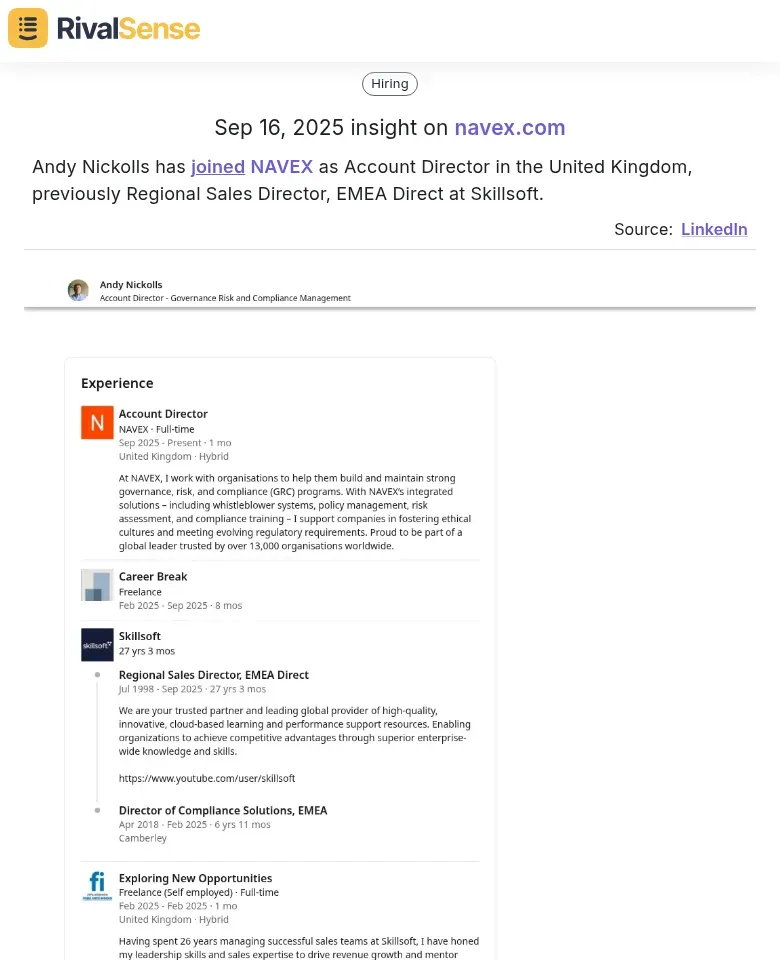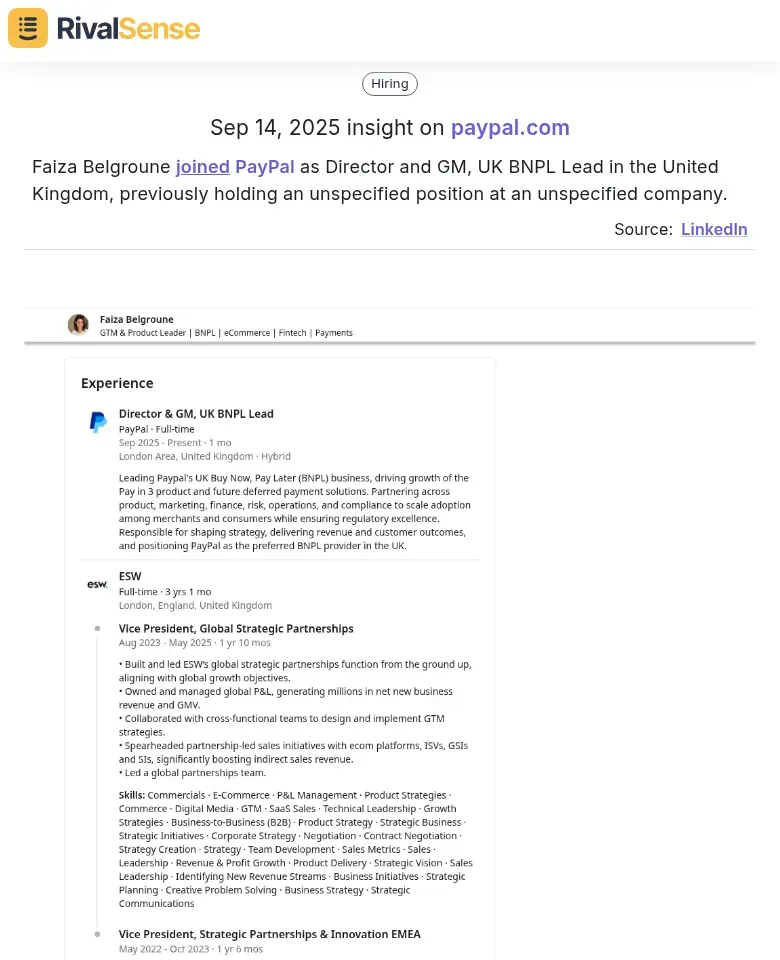How to Track Competitor Employee Changes for Strategic Advantage
Employee movements serve as powerful leading indicators of strategic shifts long before public announcements. When key account personnel change roles or leave competitors, it reveals critical intelligence about organizational priorities, vulnerabilities, and market positioning. Workforce changes often precede major strategic pivots by 6-12 months, providing invaluable foresight.
Practical steps to leverage this intelligence:
• Set automated LinkedIn alerts for executive and key account manager changes at competitor companies
• Monitor job postings for patterns indicating new market focus or product development
• Track cross-industry executive moves that signal diversification strategies
• Correlate hiring spikes with quarterly earnings and product roadmap timelines
• Benchmark layoff patterns against industry averages to identify financial distress
💡 Key insight: Companies that hire specialized account managers for specific industries or regions typically enter those markets within 6-9 months. By systematically tracking these workforce movements, you gain predictive power to adjust your competitive strategy proactively—whether that's accelerating product development, targeting newly available talent, or capitalizing on competitor vulnerabilities.
Decoding Strategic Intent from Key Account Employee Transitions
Key account employee transitions reveal powerful strategic signals when decoded properly. When a competitor's key account manager moves from a regional to national role, this often signals market expansion ambitions. Geographic relocations—like a West Coast account lead transferring to the East Coast—indicate regional strategy shifts and territory prioritization.

Example: Patrick Stapel left Coty as Senior Director Global Engineering in the Netherlands to join Lineage as Director of Engineering - Europe. This type of international executive movement often indicates geographic expansion strategies and can signal where competitors are investing resources.
Practical steps for decoding intent:
- Track role changes quarterly using LinkedIn Sales Navigator alerts
- Map geographic moves against your market expansion plans
- Analyze title upgrades for organizational restructuring patterns
- Monitor accompanying team expansions (new hires supporting moved employees)
- Correlate with recent competitor funding rounds or product launches
💡 Key insight: Employee moves often precede public announcements by 3-6 months. A key account team expanding into a new region frequently indicates upcoming market entry before official launch.
Tracking Talent Flows: From Departures to New Hires
Tracking talent flows provides unparalleled visibility into competitor strategies. Executive departures often signal internal challenges or strategic pivots—monitor LinkedIn and press releases for C-suite changes. Analyze hiring patterns: surges in AI/tech roles hint at product development, while international positions suggest geographic expansion.

Example: Andy Nickolls has joined NAVEX as Account Director in the United Kingdom, previously Regional Sales Director, EMEA Direct at Skillsoft. Tracking such cross-company movements helps identify talent pipelines and reveals which companies are actively recruiting from specific competitors, indicating strategic priorities.
📋 Practical Checklist:
- Set automated alerts for competitor job postings and LinkedIn updates
- Monitor executive departures for leadership gap insights
- Analyze departmental hiring spikes against market trends
- Track talent migration patterns between rival companies
- Research new hires' backgrounds to uncover strategic priorities
- Cross-reference with funding rounds or patent filings for context
- Schedule monthly intelligence reviews with leadership teams
🚀 Pro tip: Use specialized tools like RivalSense to automate monitoring and receive actionable weekly insights on key personnel changes across all critical competitors.
Leveraging Employee Changes for Competitive Advantage
Employee changes at rival companies provide invaluable competitive intelligence that most businesses overlook. When key personnel depart or new specialists join, these movements signal strategic shifts months before public announcements. For instance, a surge in AI hiring often precedes product launches, while executive turnover may indicate internal challenges or strategic pivots.

Example: Faiza Belgroune joined PayPal as Director and GM, UK BNPL Lead in the United Kingdom. Such specialized hires often indicate new market initiatives or product expansions—in this case, PayPal's focus on Buy Now, Pay Later services in the UK market.
Practical steps to leverage this intelligence:
- Set automated alerts for competitor job postings and LinkedIn updates
- Monitor executive movements and departmental hiring spikes
- Analyze patterns against market trends and funding rounds
- Research new hires' backgrounds to uncover strategic priorities
- Identify timing opportunities during competitor transitions
Develop targeted strategies by assessing organizational strengths and weaknesses revealed through workforce movements. When competitors lose critical talent or restructure leadership, capitalize on their vulnerabilities by accelerating your own initiatives or targeting their weakened areas.
Practical Tools and Methods for Effective Employee Tracking
Implement Automated Monitoring Systems: Set up tools like LinkedIn Sales Navigator to receive real-time alerts when key employees at competitor companies change roles. Configure automated tracking for specific job titles, departments, or leadership positions.
Leverage Professional Networks: Create saved searches on LinkedIn for competitor companies and key personnel. Follow company pages and set up email alerts for new hires, promotions, or departures. Utilize Sales Navigator's advanced filters to track specific roles, locations, or seniority levels.
Establish Systematic Analysis Processes: Develop a standardized workflow:
- Collect employee movement data daily
- Categorize changes by department/role significance
- Analyze patterns (hiring sprees = expansion; mass exits = trouble)
- Document insights in a central dashboard
- Schedule weekly reviews to identify strategic opportunities or threats
Create checklists for immediate action steps when key executives depart or new talent joins competitors.
Turning Insights into Action: Strategic Implementation
Integrate employee tracking data into your competitive intelligence framework by creating a structured workflow. Map talent flows between companies to identify strategic hiring patterns and benchmark workforce metrics against industry peers.
Develop proactive response strategies by establishing a decision matrix:
- When competitors hire AI specialists → accelerate your own AI initiatives
- When they experience executive departures → target their vulnerable accounts
- When they expand into new regions → assess your market position there
Measure impact through quarterly competitive positioning scores, tracking how workforce intelligence influenced strategic decisions and market share gains.
📊 Practical tip: Create a "competitor org chart heat map" showing stability (green), volatility (yellow), and opportunity zones (red) based on employee movement data.
Ready to Transform Your Competitive Intelligence?
Tracking employee changes manually across multiple competitors can be overwhelming. RivalSense automates this process by monitoring competitor product launches, pricing updates, event participations, partnerships, regulatory aspects, management changes, and media mentions across company websites, social media, and various registries.
Get your first competitor report today and start receiving actionable weekly insights that help you stay ahead of market shifts. Try RivalSense for free and turn competitor intelligence into your strategic advantage.
📚 Read more
👉 How Vanta's AI GTM Strategy Reveals Critical Competitor Insights
👉 Unlocking Competitor Social Media Advantages: A Strategic Guide for Business Leaders
👉 How Early Detection of Mapon's Route Planning Expansion Saved 15% Market Share
👉 Data-Driven Website Insights: Track Competitors to Secure Key Account Renewals
